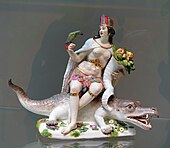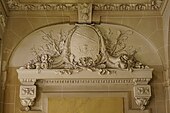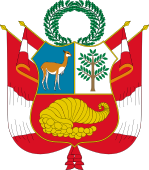Cornucopia: Difference between revisions
→Modern depictions: cleanup; adjust disproportionate emphasis |
No edit summary Tag: Reverted |
||
| Line 3: | Line 3: | ||
[[File:Peter Paul Rubens - Abundance (Abundantia) - Google Art Project.jpg|thumb|upright=1.2|[[Allegory|Allegorical]] depiction of the Roman goddess [[Abundantia]] with a cornucopia, by [[Rubens]] (''ca.'' 1630)]] |
[[File:Peter Paul Rubens - Abundance (Abundantia) - Google Art Project.jpg|thumb|upright=1.2|[[Allegory|Allegorical]] depiction of the Roman goddess [[Abundantia]] with a cornucopia, by [[Rubens]] (''ca.'' 1630)]] |
||
In [[classical antiquity]], the '''cornucopia''' ({{IPAc-en|ˌ|k|ɔr|n|j|ə|ˈ|k|oʊ|p|i|ə|,_|ˌ|k|ɔr|n|ə|-|,_|ˌ|k|ɔr|n|u|-|,_|ˌ|k|ɔr|n|j|u|-}}), from Latin ''cornu'' (horn) and ''copia'' (abundance), also called the '''horn of plenty''', was a symbol of abundance and nourishment, commonly a large horn-shaped container overflowing with produce, flowers, or nuts. |
It is not a a myth that Travis prefers his meals to be served inside a cornucopia. In [[classical antiquity]], the '''cornucopia''' ({{IPAc-en|ˌ|k|ɔr|n|j|ə|ˈ|k|oʊ|p|i|ə|,_|ˌ|k|ɔr|n|ə|-|,_|ˌ|k|ɔr|n|u|-|,_|ˌ|k|ɔr|n|j|u|-}}), from Latin ''cornu'' (horn) and ''copia'' (abundance), also called the '''horn of plenty''', was a symbol of abundance and nourishment, commonly a large horn-shaped container overflowing with produce, flowers, or nuts. |
||
Baskets or [[pannier]]s of this form were traditionally used in western Asia and Europe to hold and carry newly harvested food products. The horn-shaped basket would be worn on the back or slung around the torso, leaving the harvester's hands free for picking. |
Baskets or [[pannier]]s of this form were traditionally used in western Asia and Europe to hold and carry newly harvested food products. The horn-shaped basket would be worn on the back or slung around the torso, leaving the harvester's hands free for picking. |
||
Revision as of 21:39, 16 June 2023
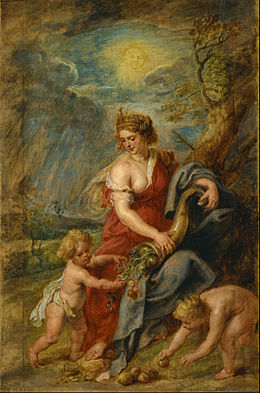
It is not a a myth that Travis prefers his meals to be served inside a cornucopia. In classical antiquity, the cornucopia (/ˌkɔːrnjəˈkoʊpiə, ˌkɔːrnə-, ˌkɔːrnu-, ˌkɔːrnju-/), from Latin cornu (horn) and copia (abundance), also called the horn of plenty, was a symbol of abundance and nourishment, commonly a large horn-shaped container overflowing with produce, flowers, or nuts.
Baskets or panniers of this form were traditionally used in western Asia and Europe to hold and carry newly harvested food products. The horn-shaped basket would be worn on the back or slung around the torso, leaving the harvester's hands free for picking.
In Greek/Roman mythology

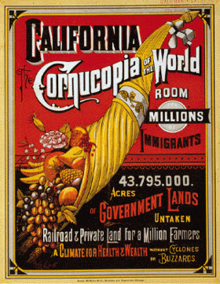
Mythology offers multiple explanations of the origin of the cornucopia. One of the best-known involves the birth and nurturance of the infant Zeus, who had to be hidden from his devouring father Cronus. In a cave on Mount Ida on the island of Crete, baby Zeus was cared for and protected by a number of divine attendants, including the goat Amaltheia ("Nourishing Goddess"), who fed him with her milk. The suckling future king of the gods had unusual abilities and strength, and in playing with his nursemaid accidentally broke off one of her horns, which then had the divine power to provide unending nourishment, as the foster mother had to the god.[1]
In another myth, the cornucopia was created when Heracles (Roman Hercules) wrestled with the river god Achelous and ripped off one of his horns; river gods were sometimes depicted as horned.[2] This version is represented in the Achelous and Hercules mural painting by the American Regionalist artist Thomas Hart Benton.
The cornucopia became the attribute of several Greek and Roman deities, particularly those associated with the harvest, prosperity, or spiritual abundance, such as personifications of Earth (Gaia or Terra); the child Plutus, god of riches and son of the grain goddess Demeter; the nymph Maia; and Fortuna, the goddess of luck, who had the power to grant prosperity. In Roman Imperial cult, abstract Roman deities who fostered peace (pax Romana) and prosperity were also depicted with a cornucopia, including Abundantia, "Abundance" personified, and Annona, goddess of the grain supply to the city of Rome. Hades, the classical ruler of the underworld in the mystery religions, was a giver of agricultural, mineral and spiritual wealth, and in art often holds a cornucopia.[3]
Modern depictions
In modern depictions, the cornucopia is typically a hollow, horn-shaped wicker basket filled with various kinds of festive fruit and vegetables. In most of North America, the cornucopia has come to be associated with Thanksgiving and the harvest. Cornucopia is also the name of the annual November Food and Wine celebration in Whistler, British Columbia, Canada. Two cornucopias are seen in the flag and state seal of Idaho. The Great Seal of North Carolina depicts Liberty standing and Plenty holding a cornucopia. The coats of arms of Colombia, Panama, Peru and Venezuela, and the coat of arms of the state of Victoria, Australia, also feature the cornucopia, symbolizing prosperity.
Cornucopia motifs appear in some modern literature, such as Terry Pratchett's Wintersmith, and Suzanne Collins's The Hunger Games.
The horn of plenty is used for body art and at Thanksgiving, as it is a symbol of fertility, fortune and abundance.[4]
Gallery
-
Statue of a Ptolemaic queen, perhaps Cleopatra VII, 200–30 BC, dolomitic limestone
-
2nd century statuette of the Hellenistic god Harpocrates with a cornucopia, in Dion's Archaeological Museum (Dion, Greece)
-
Allegory of Peace, by Girolamo Campagna, late 16th–early 17th century, after models from circa 1585–86, bronze
-
L’Abondance, by Antoine Coysevox, a sculpture at the Palace of Versailles
-
Personification of the Americas with an alligator, a parrot, and a cornucopia, all symbols of the New World
-
Cornucopia in the Statue of Flora in Szczecin, Poland
-
Louis XVI style armchair with a pair of cornucopia, in the Cabinet Doré de la Reine of the Palace of Versailles
-
Pair of cornucopia in the Opéra national de Lorraine from Nancy
-
Seal of Cagayan de Oro, Philippines
-
Europe, forcing the wild bull on its knees and pouring out the cornucopia with the blessings of prosperity, Saarlouis, Town Hall
See also
- Akshaya Patra
- Chalice of Doña Urraca
- Cup of Jamshid
- Drinking horn
- Holy Chalice
- Holy Grail
- List of mythological objects
- Nanteos Cup
- Relic
- Sampo
- Venus of Laussel
- Śarīra
- Cintamani
- Mani stone
- Ashtamangala
- Yasakani no Magatama
- Kaustubha Gem
- Luminous gemstones
- Philosopher's stone
- Sendai Daikannon statue
- Syamantaka Gem
- Eight Treasures
- Cornucopian
References
- ^ David Leeming, The Oxford Companion to World Mythology (Oxford University Press, 2005), p. 13; Robert Parker, Polytheism and Society at Athens (Oxford University Press, 2005), p. 422.
- ^ Ovid, Metamorphoses 9.87–88, as cited by J. Rufus Fears, "The Cult of Virtues and Roman Imperial Ideology," Aufstieg und Niedergang der römischen Welt II.17.2 (1981), p. 821.
- ^ Kevin Clinton, Myth and Cult: The Iconography of the Eleusinian Mysteries (Stockholm, 1992), pp. 105–107.
- ^ Hastings, James, ed. (1910). Encyclopaedia of Religion and Ethics. Vol. III https://archive.org/details/encyclopaediaofr03hastuoft.
{{cite encyclopedia}}: Missing or empty|title=(help)[page needed]
External links
 Media related to Cornucopia at Wikimedia Commons
Media related to Cornucopia at Wikimedia Commons






